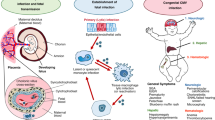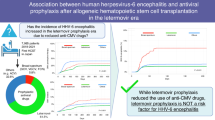Abstract
OBJECTIVE:
Infants with neonatal herpes, classified as central nervous system or disseminated disease, have a high incidence of moderate and severe neurologic deficits despite standard acute therapy.
STUDY DESIGN:
Following completion of parenteral therapy, infants with central nervous system and/or disseminated disease received 2 years of continuous oral acyclovir therapy. Target minimum peak serum acyclovir concentrations were >2 μg/ml for the first three patients, and >3 μg/ml for the subsequent 13 patients. Safety assessments were made every 3 months. We evaluated neurodevelopmental outcomes with Bayley Scales of Infant Development.
RESULTS:
A total of 16 consecutive herpes simplex virus-infected infants born during 1990 to 2003 received the treatment plan; 13/16 infants had central nervous system disease; 3 had disseminated disease without central nervous system involvement. A total of 69% (11/16) had Bayley scores in the normal range for mental development and 79% (11/14) had motor scores in the normal range. At the final assessment, five children had developmental delays. One child had severe mental delay with normal motor development. Four children had mild mental delays, with severe motor delays in three. All children were independently mobile, without seizure disorder, had normal vision, and had speech development. During the 2-year course of treatment, five children had brief recurrences of dermal lesions, and none had evidence of neurologic deterioration. There were no serious or sustained adverse drug reactions.
CONCLUSION:
This pilot study reports improved outcomes in a small cohort of infants with a prolonged course of oral acyclovir. A minority of these children exhibited mild or significant developmental delays. Further investigation of this approach to treatment is warranted.
This is a preview of subscription content, access via your institution
Access options
Subscribe to this journal
Receive 12 print issues and online access
$259.00 per year
only $21.58 per issue
Buy this article
- Purchase on Springer Link
- Instant access to full article PDF
Prices may be subject to local taxes which are calculated during checkout
Similar content being viewed by others
References
Malm G, Forsgren M, elAzizi M, Persson A . A follow-up study of children with neonatal herpes simplex virus infections with particular regard to late nervous disturbances. Acta Paediatr Scand 1991;80:226–234.
Whitley R, Arvin A, Prober C, et al. A controlled trial comparing vidarabine with acyclovir in neonatal herpes simplex virus infections. N Eng J Med 1991;324:444–449.
Kimberlin DW, Lin C-Y, Jacobs RF, et al. Natural history of neonatal herpes simplex virus infections in the acyclovir era. Pediatr 2001;108:223–229.
Kimura H, Aso K, Kuzushima K, Hanada N, Shibata M, Morishima T . Relapse of herpes simplex encephalitis in children. Pediatrics 1992;89(5):891–894.
Collins P, Appleyard GA, Oliver NM . Sensitivity of herpesvirus isolates from acyclovir clinical trials. Am J Med 1982;73:380–382.
Dorsky DI, Crumpacker CS . Drugs five years later: acyclovir. Ann Inter Med 1987;107:859–874.
Lycke J, Anderson O, Svennerholm B, et al. Acyclovir concentrations in serum and cerebrospinal fluid at steady state. J Antimicrobial Chemother 1989;24:947–954.
Blum MR, Liao SHT, De Miranda P . Overview of acyclovir pharmacokinetic disposition in adults and children. Am J Med 1982;73:186–192.
Rudd C, Rivadeneira ED, Gutman LT . Dosing considerations for oral acyclovir following neonatal herpes disease. Acta Paediatr 1994;83:1237–1243.
Bayley N . The Bayley Scales of Infant Development. San Antonio: The Psychological Corporation 1969 and 1993.
Kimberlin DW, Lin C-Y, Jacobs RF, et al. Safety and efficacy of high-dose intravenous acyclovir in the management of neonatal herpes simplex virus infection. Pediatries 2001;108:230–238.
Koskiniemi M, Happonen J-M, Jarvenpaa A-L, et al. Neonatal herpes simplex virus infection: a report of 43 patients. Pediatr Infect Dis J 1989;8:30–35.
Kimberlin DW . Herpes simplex infections of the central nervous system. Semin Pediat Infect Dis 2003;14:83–89.
Kimberlin DW, Lakeman FD, Arvin AM, et al. Application of the polymerase chain reaction to the diagnosis and management of neonatal herpes simplex virus disease. J Infect Dis 1996;174:1162–1167.
Whitley R, Arvin A, Prober C, et al. Predictors of morbidity and mortality in neonates with herpes simplex virus infections. N Eng J Med 1991;324:450–454.
Corey L, Whitley R, Stone EF, Mohan K . Difference between herpes simplex virus type 1 and type 2 neonatal encephalitis in neurological outcome. The Lancet 1988;1:1–4.
Goldberg LH, Kaufman R, Kurtz TO, et al. Long-term suppression of recurrent genital herpes with acyclovir. Arch Dermatol 1993;129:582–587.
Tilson HH, Engle CR, Andrews EB . Safety of acyclovir: a summary of the first 10 years experience. J Med Virol Suppl 1993;1:67–73.
Feder Jr H, Goyal R, Krause P . Acyclovir-Induced Neutropenia in an infant with herpes simplex encephalitis: case report. Clin Infect Dis 1995;20:1557–1559.
Kimberlin D, Powell D, Gruber W, et al. Administration of oral acyclovir suppressive therapy after neonatal herpes simplex virus disease limited to the skin, eyes, and mouth: results of a phase I/II trial. Pediatr Infect Dis J 1996;15:247–254.
Feldman S, Doolittle M, Roberson P, Hughes WT . Similar hematological changes in children receiving trimethoprim–sulfamethoxazole or amoxicillin for otitis media. J Pediatr 1985;106:995–1000.
Fife KH, Crumpacker CS, Mertz GJ, et al. Recurrence and resistance patterns of herpes simplex virus following cessation of >6 years of chronic suppression with acyclovir. J Infect Dis 1994;169:1338–1341.
Author information
Authors and Affiliations
Additional information
Dr. Benjamin received support from the National Institute of Child Health and Human Development (NICHD: HD-03-001; North Carolina Collaborative PPRU).
Rights and permissions
About this article
Cite this article
Tiffany, K., Benjamin, D., Palasanthiran, P. et al. Improved Neurodevelopmental Outcomes following Long-Term High-Dose Oral Acyclovir Therapy in Infants with Central Nervous System and Disseminated Herpes Simplex Disease. J Perinatol 25, 156–161 (2005). https://doi.org/10.1038/sj.jp.7211247
Published:
Issue Date:
DOI: https://doi.org/10.1038/sj.jp.7211247
This article is cited by
-
Improving Neurodevelopmental Outcomes After Neonatal Herpes Simplex Virus Infection
Journal of Perinatology (2005)



